U.S. Department of Transportation
Federal Highway Administration
1200 New Jersey Avenue, SE
Washington, DC 20590
202-366-4000
Improved signing and sign conspicuity can provide warnings to drivers as they approach potentially hazardous scenarios, such as intersections and horizontal curves. Some treatments in this section also appear in the sections on intersection improvements and horizontal curve improvements.
| Safety Treatment | For more information, visit page | Cost | Frequency of Maintenance (years) | Safety Benefit | Benefit Cost Ratio36 | |||||
|---|---|---|---|---|---|---|---|---|---|---|
| Initial Implementation | Ongoing Maintenance | NCHRP 500 Performance Rating | Crash Modification Factor (CMF) | Lower Volume*, Optimal Conditions*** | Higher Volume**, Optimal Conditions*** | Lower Volume*, Narrower Conditions**** | Higher Volume**, Narrower Conditions**** | |||
| Install/Upgrade Curve Warning Signs with Fluorescent Yellow Sheeting |
132 | $ | - | 5 | P | 0.66 | 63.1 | 490.4 | 75.1 | 739.9 |
| Install Curve Warning Signs | 133 | $ | $ | 5 | P | 0.70 | 33.8 | 270.1 | 43.5 | 428.4 |
| Install Retroreflective Strips on Sign Posts | 134 | $ | T | |||||||
| Double Use of Advanced Warning Signs for Curves or Intersections |
135 | $ | T | |||||||
| Provide Upcoming Road Names on Advanced Warning Signs |
136 | $ | T | 0.90-0.99 | ||||||
| Install Advanced Intersection Warning Signs | 137 | $ | T | |||||||
| Upgrade to Larger Stop Signs | 138 | $ | P | |||||||
| Double Use of Stop Signs | 139 | $ | T | |||||||
| Use of Supplemental Warning Signs | 140 | $ | T | |||||||
| Install Chevron Signs | 141 | $$ | $ | 5 | P | 0.75 | 10.6 | 84.7 | 13.0 | 127.7 |
Cost: NCHRP 500 Performance rating37 *Lower Volume ≤ 1000 vpd |
||||||||||
Fluorescent yellow sheeting can improve the effectiveness of curve warning and delineation signs by increasing the conspicuity of the sign, especially during dark conditions.
Where to Use: Connecticut DOT used fluorescent yellow sheeting to improve signing at horizontal curves between 2002 and 2006. These curves were selected through a regular program called the Suggested List of Surveillance Study Sites (SLOSSS), which uses crash data, traffic volumes, and roadway characteristics to identify intersections and road segments with higher than expected crash rates.
| Install/Upgrade Curve Warning Signs with Fluorescent Yellow Sheeting - Initial Investment: $1,280 - Cost of Maintenance: n/a - Frequency of Maintenance: 5 years (2 applications) |
Benefit-Cost Ratio | NCHRP 500 Performance Rating | Crash Modification Factor (CMF) |
|---|---|---|---|
| Lower Volume Optimal Conditions | 63.1 | Proven | 0.66 |
| Higher Volume Optimal Conditions | 490.4 | Proven | 0.66 |
| Lower Volume Narrower Conditions | 75.1 | Proven | 0.66 |
| Higher Volume Narrower Conditions | 739.9 | Proven | 0.66 |
Top Recommended Resources:
1. FHWA, Safety Evaluation of Improved Curve Delineation, September 2009. Available at: https://www.fhwa.dot.gov/publications/research/safety/09045/09045.pdf
2. FHWA, Low Cost Treatments for Horizontal Curve Safety, December 2006. Available at: http://safety.fhwa.dot.gov/roadway_dept/horicurves/fhwasa07002/.
Some of the most serious crashes on rural roads occur at horizontal curves. Horizontal alignment signs, informally called curve warning signs, can improve safety by alerting drivers to changes in roadway geometry that may not be apparent or expected. These signs provide visual information for the driver about the nature of the curve they are approaching, letting them know whether it's a gradual curve, a sharp turn, a hairpin turn, or some combination. Different types of curve warning signs are identified in the MUTCD.
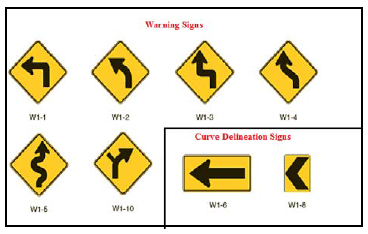
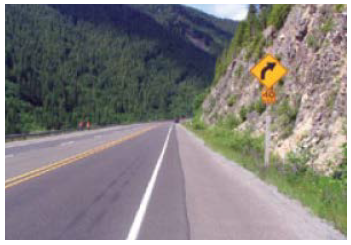
Where to Use: Curve warning signs should be applied to any curve or turn with a history of roadway departure crashes and curves or turns with similar geometry or traffic volumes yet to experience crashes. According to the 2009 MUTCD, warning signs are required on curves or turns where the advisory speed is 10 mph less than the posted speed.
Studies have shown that reductions in crashes due to the installation of curve warning signs are more prominent at locations with higher traffic volumes, sharper curves, or hazardous roadsides.
| Install Curve Warning Signs - Initial Investment: $2,400 - Cost of Maintenance: $1,280 - Frequency of Maintenance: 5 years |
Benefit-Cost Ratio | NCHRP 500 Performance Rating | Crash Modification Factor (CMF) |
|---|---|---|---|
| Lower Volume Optimal Conditions | 33.8 | Proven | 0.70 |
| Higher Volume Optimal Conditions | 207.1 | Proven | 0.70 |
| Lower Volume Narrower Conditions | 43.5 | Proven | 0.70 |
| Higher Volume Narrower Conditions | 428.4 | Proven | 0.70 |
Top Recommended Resources:
1. University of California, Berkley, Institute of Transportation Studies, Technology Transfer Program, Tech Transfer Newsletter, "Signs for Curves and Turns." Available at: http://www.techtransfer.berkeley.edu/newsletter/08-2/signs-for-curves-and-turns.php.
2. FHWA, Roadway Departure Safety: A Manual for Local Rural Road Owners, January 2011. Available at: http://safety.fhwa.dot.gov/local_rural/training/fhwasa1109/fhwasa1109.pdf.
The use of retroreflective strips on sign posts may be beneficial when there is a need to draw additional attention to the signs, especially at night. Reflective strips may be added to Stop signs, curve or intersection warning signs, regulatory or guidance signs, etc.
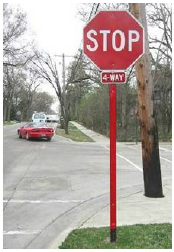
Where to Use: The MUTCD provides the following guidance for the use of reflective strips on sign posts: "The material must be at least 2 inches wide and must be placed the full length of the post, from the sign to within 2 feet above the horizontal surface into which the sign is fixed. In addition, the color of the material must match the background color of the sign except that the color of the strip for Yield and Do Not Enter signs must be red."
| Safety Treatment | Initial Implementation Cost | NCHRP 500 Performance Rating |
|---|---|---|
| Install Retroreflective Strips on Sign Posts | $0 to $5,000 | Tried |
Top Recommended Resource:
1. FHWA, "Intersection Safety Implementation Plan Workshop," presentation, July 2009. Available at: http://safety.fhwa.dot.gov/intersection/other_topics/fhwasa10010/fhwasa10010.pdf.
Doubling the use of either Intersection Ahead warning signs or Curve Ahead warning signs (i.e., on the left and right) is recommended for locations where the crash rates have not been reduced after installation of a single advanced warning sign.
Where to Use: This treatment may be used at locations where crashes indicate that motorists do not heed existing advanced warning signs and additional conspicuity is needed.
| Safety Treatment | Initial Implementation Cost | NCHRP 500 Performance Rating |
|---|---|---|
| Double Use of Advanced Warning Signs for Curves or Intersections | $0 to $5,000 | Tried |
Top Recommended Resource:
1. FHWA, Low Cost Treatments for Horizontal Curve Safety, December 2006. Available at: http://safety.fhwa.dot.gov/roadway_dept/horicurves/fhwasa07002/.
At locations where Intersection Ahead warning signs are used, it is recommended that street name plaques be placed underneath the upcoming street sign. These street name plaques provide the driver with additional information about the street so he or she can make an early decision regarding potential turning movements.
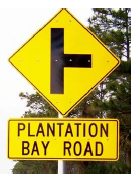
Where to Use: This treatment may be used at locations where crashes could potentially be reduced by providing advanced turn information.
| Safety Treatment | Initial Implementation Cost | NCHRP 500 Performance Rating | Crash Modification Factor (CMF) |
|---|---|---|---|
| Provide Upcoming Road Names on Advanced Warning Signs | $0 to $5,000 | Tried | 0.90-0.99 |
Advanced intersection warning signs can help alert drivers to the presence of an intersection ahead. Signs can be placed with sufficient distance prior to the intersection to allow drivers to perceive and react. They can also be installed on both sides of the roadway to solicit greater awareness.
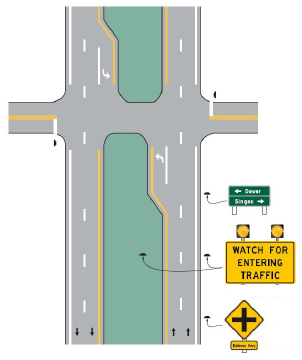
Where to Use: Advanced intersection warning signs are to be applied predominantly on single through lane, high-crash, stop-controlled State intersections in both rural and urban areas. They may also be applied on dual through lane, high-crash, stop-controlled intersections with lower traffic volumes (less than about 25,000 average annual daily traffic (AADT)) where the use of J-treatments is not appropriate and the frequency of acceptable gaps for entering traffic is such that long waiting and higher risk taking are present at the intersection.
| Safety Treatment | Initial Implementation Cost | NCHRP 500 Performance Rating |
|---|---|---|
| Install Advanced Intersection Warning Signs | $0 to $5,000 | Tried |
Top Recommended Resources:
1. FHWA, Stop-Controlled Intersection Safety: Through Route Activated Warning Systems, February 2011.
A high number of crashes relate to the driver's inability or failure to see the Stop sign at stop-controlled intersections. To improve recognition of the signs, larger Stop signs can be installed. Sizes can range from 30 inches, to 36 inches, to 48 inches and larger, if needed.
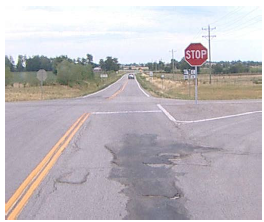
Where to Use: While roadway classification and speed can help determine proper Stop sign size, larger sizes may be used when crash types indicate that Stop sign visibility may be an issue.
| Safety Treatment | Initial Implementation Cost | NCHRP 500 Performance Rating |
|---|---|---|
| Upgrade to Larger Stop Signs | $0 to $5,000 | Proven |
Top Recommended Resource:
1. FHWA, Stop Sign-Controlled Intersections: Enhanced Signs and Markings–A Winston-Salem Success Story, November 2009. Available at: http://safety.fhwa.dot.gov/intersection/resources/casestudies/fhwasa09010/.
Two Stop signs (mounted left and right) can be used to call greater attention to the need for motorists to stop at an intersection. The first Stop sign is installed at the traditional right side location; a second is recommended in the median (if available) of the approach. To accommodate this left-mounted Stop sign, a small mountable curb is suggested. This curb and associated pavement markings provide the motorist with additional information that he or she is entering an intersection.
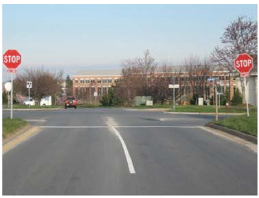
Where to Use: This treatment may be used at locations where crashes indicate that motorists do not obey existing Stop signs and additional intersection conspicuity is needed.
| Safety Treatment | Initial Implementation Cost | NCHRP 500 Performance Rating |
|---|---|---|
| Double Use of Stop Signs | $0 to $5,000 | Tried |
Top Recommended Resources:
1. FHWA, Intersection Safety: A Manual for Local Rural Road Owners, January 2011. Available at: http://safety.fhwa.dot.gov/local_rural/training/fhwasa1108/fhwasa1108.pdf.
2. FHWA, Stop Sign-Controlled Intersections: Enhanced Signs and Markings – A Winston-Salem Success Story, November 2009. Available at: http://safety.fhwa.dot.gov/intersection/resources/casestudies/fhwasa09010/.
When specialized conditions exist, supplemental warning signs may be used to notify road users of the possibility that slower and more susceptible road users may be ahead. Examples include Share The Road, Trail Crossing, and Equestrian Crossing signs.
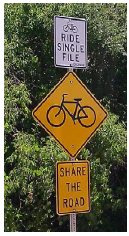
Where to Use: These signs may be used whenever road users need to be notified that slower traffic crosses the roadway or exists on or very near the roadway.
| Safety Treatment | Initial Implementation Cost | NCHRP 500 Performance Rating |
|---|---|---|
| Double Use of Stop Signs | $0 to $5,000 | Tried |
Chevron signs (or curve delineation signs) indicate to drivers the alignment of the roadway when they are within the actual horizontal alignment of a curve. The signs show the shape and degree of curvature, and they guide drivers through the entire curve or turn.
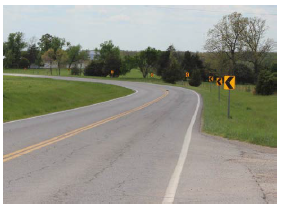
Where to Use: Chevrons should be installed at any curve or turn with a history of roadway departure crashes and at curves or turns with similar geometry or traffic volume yet to experience crashes. According to the 2009 MUTCD, alignment delineation (or a single-directional large arrow) is required on curves or turns where the advisory speed is 15 mph less than the posted speed limit. They can be installed at locations where no chevrons currently exist, or to supplement chevrons that are already in place.
Top Recommended Resource:
1. FHWA, Roadway Departure Safety: A Manual for Local Rural Road Owners, January 2011. Available at: http://safety.fhwa.dot.gov/local_rural/training/fhwasa1109/fhwasa1109.pdf.
36 As discussed in Section 1.2, a BCR is only shown where data were available to calculate the ratio. Where data were unavailable, the BCR has been left blank. [ Return to note 36. ]
37 As stated in NCHRP Series 500 Reports (http://safety.transportation.org/guides.aspx). Proven: The safety effect for other similar applications has shown a proven benefit. Tried: The treatment has indications that it can be expected to reduce crashes, but has some conflicting reports as to its associated safety effects or has been deployed and observed to be effective. Experimental: New treatments that still need to be tested and for which the safety effect is unknown. Unknown: Not enough is known about an associated safety performance. [ Return to note 37. ]
